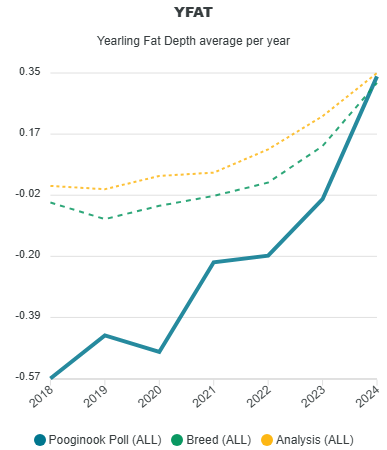Carcase & Growth
Targeted traits:
Growth, Fat & Muscle.
Overview
The Carcase & Growth pillar focuses on the commercially critical traits that influence how your sheep grow, finish, and perform in real-world environments. We aim to produce animals that grow efficiently, handle stress well, and meet market targets without pushing them beyond practical management limits.
Our programme targets early growth for faster turn-off, improved muscling for more saleable meat, and moderate adult weights that support stocking rates and longevity. We’re not chasing extremes — we’re building balanced animals that convert feed into kilograms, reach joining weights sooner, and hold their shape where it counts.
Every selection decision is backed by performance data, real on-farm outcomes, and constant review. These traits aren’t chosen because they look good on paper — they’re selected because they deliver in the paddock.
1. Post Weaning Weight (PWT)
Post Weaning Weight tracks growth during the critical phase after weaning and before full maturity. It tells us how consistently an animal continues to gain weight when it's no longer supported by the ewe. This is especially important for operations aiming to finish lambs efficiently or hit market specs without holding them back.
By 2030, we’re targeting a continued upward trend in PWT to reduce the time from weaning to market. It’s a key driver in our strategy to improve finishing ability while still maintaining moderate adult weights and strong structural integrity.
2. Yearling Weight (YWT)
Yearling Weight reflects how much growth a sheep achieves in its first year of life. It gives a strong indication of early maturity and overall growth efficiency, helping identify sheep that reach joining or sale weight faster. High YWT values also correlate with shorter finishing times, better feed conversion, and stronger early performance.
Our 2030 target is to continue improving early growth without pushing mature weight beyond what works in commercial systems. Increasing YWT supports faster returns while keeping structure and do-ability in balance — a key part of producing rams that work in the paddock, not just on paper.
3. Adult Weight (AWT)
Adult Weight gives us the clearest picture of long-term size and carrying cost. While heavier animals often grow faster, unchecked mature weight can lead to management issues, lower stocking rates, and increased feed costs. AWT helps us balance growth with practicality — especially for ewes expected to last multiple seasons.
Our goal for 2030 is to maintain AWT at a level that supports productivity without compromising handling, reproduction or longevity. It’s about keeping weight where it works — big enough to perform, but not too big to manage.
4. Fat Depth (YFAT)
Fat Depth plays a critical role in resilience, fertility and animal welfare. More fat at the right stage supports joining success, lamb survival and post-lambing recovery. It also helps sheep maintain energy during feed gaps or seasonal stress — especially in tougher grazing systems.
By 2030, we’re targeting a higher average for YFAT to support fertility, do-ability and lifetime productivity — without compromising frame or fleece. It’s one of the most underrated, yet commercially valuable traits in the system.
5. Eye Muscle Depth (YEMD)
Eye Muscle Depth is a direct measure of muscling and lean meat yield. It’s one of the clearest indicators of carcase value and a major influence on processor and market preference. By selecting for YEMD, we’re building sheep that convert feed into saleable meat more efficiently.
Our 2030 target is to lift YEMD across our sale rams into the top 25% — helping clients produce lambs that finish faster, yield better, and meet market targets with fewer drafts.
In Summary
Carcase and growth traits are the foundation of building sheep that perform commercially — fast growth, quality carcase, and resilience without pushing size beyond practical limits. Every ram we breed is measured against these benchmarks, with a clear focus on lifting early growth, muscling and fat cover by 2030, while maintaining balance where it matters most. It’s not about chasing extremes — it’s about delivering consistent, predictable performance on-farm.

Keep Exploring
Every trait you’ve just read about is part of a bigger picture. If you’re ready to dive deeper, compare your own data, or see how it all connects — keep going.
There’s more to learn, more to apply, and our team’s here to guide you through it.





